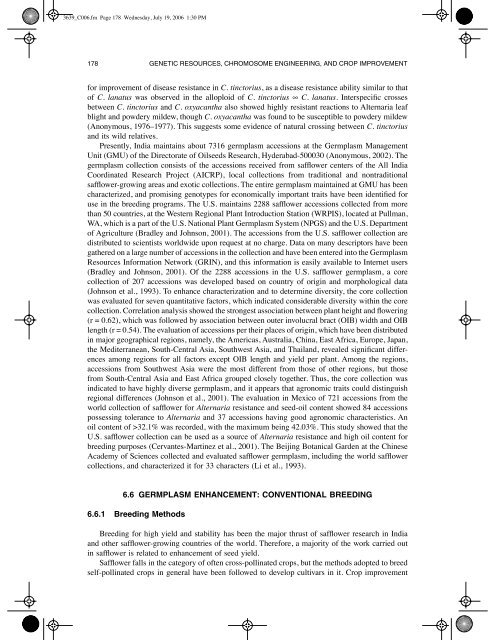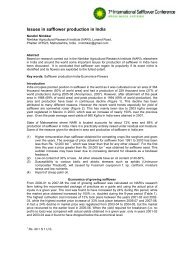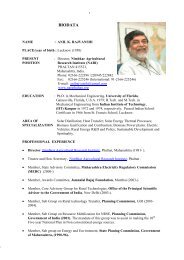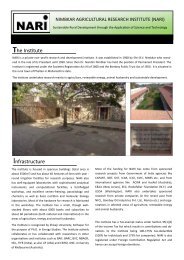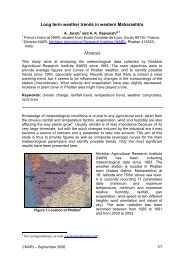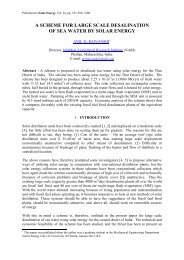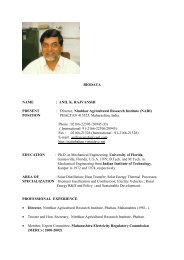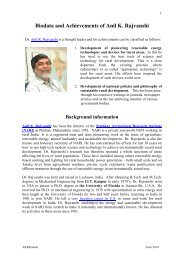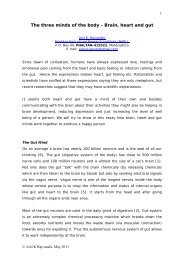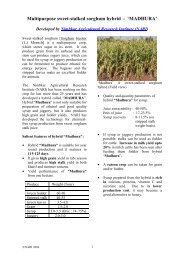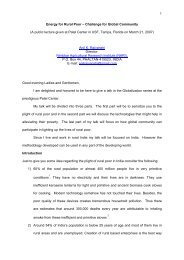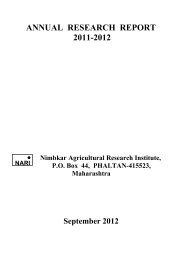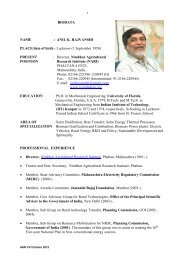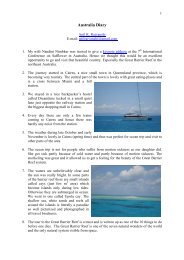Safflower (Carthamus tinctorius L.) - NARI
Safflower (Carthamus tinctorius L.) - NARI
Safflower (Carthamus tinctorius L.) - NARI
Create successful ePaper yourself
Turn your PDF publications into a flip-book with our unique Google optimized e-Paper software.
3639_C006.fm Page 178 Wednesday, July 19, 2006 1:30 PM178 GENETIC RESOURCES, CHROMOSOME ENGINEERING, AND CROP IMPROVEMENTfor improvement of disease resistance in C. <strong>tinctorius</strong>, as a disease resistance ability similar to thatof C. lanatus was observed in the alloploid of C. <strong>tinctorius</strong> ∞ C. lanatus. Interspecific crossesbetween C. <strong>tinctorius</strong> and C. oxyacantha also showed highly resistant reactions to Alternaria leafblight and powdery mildew, though C. oxyacantha was found to be susceptible to powdery mildew(Anonymous, 1976–1977). This suggests some evidence of natural crossing between C. <strong>tinctorius</strong>and its wild relatives.Presently, India maintains about 7316 germplasm accessions at the Germplasm ManagementUnit (GMU) of the Directorate of Oilseeds Research, Hyderabad-500030 (Anonymous, 2002). Thegermplasm collection consists of the accessions received from safflower centers of the All IndiaCoordinated Research Project (AICRP), local collections from traditional and nontraditionalsafflower-growing areas and exotic collections. The entire germplasm maintained at GMU has beencharacterized, and promising genotypes for economically important traits have been identified foruse in the breeding programs. The U.S. maintains 2288 safflower accessions collected from morethan 50 countries, at the Western Regional Plant Introduction Station (WRPIS), located at Pullman,WA, which is a part of the U.S. National Plant Germplasm System (NPGS) and the U.S. Departmentof Agriculture (Bradley and Johnson, 2001). The accessions from the U.S. safflower collection aredistributed to scientists worldwide upon request at no charge. Data on many descriptors have beengathered on a large number of accessions in the collection and have been entered into the GermplasmResources Information Network (GRIN), and this information is easily available to Internet users(Bradley and Johnson, 2001). Of the 2288 accessions in the U.S. safflower germplasm, a corecollection of 207 accessions was developed based on country of origin and morphological data(Johnson et al., 1993). To enhance characterization and to determine diversity, the core collectionwas evaluated for seven quantitative factors, which indicated considerable diversity within the corecollection. Correlation analysis showed the strongest association between plant height and flowering(r = 0.62), which was followed by association between outer involucral bract (OIB) width and OIBlength (r = 0.54). The evaluation of accessions per their places of origin, which have been distributedin major geographical regions, namely, the Americas, Australia, China, East Africa, Europe, Japan,the Mediterranean, South-Central Asia, Southwest Asia, and Thailand, revealed significant differencesamong regions for all factors except OIB length and yield per plant. Among the regions,accessions from Southwest Asia were the most different from those of other regions, but thosefrom South-Central Asia and East Africa grouped closely together. Thus, the core collection wasindicated to have highly diverse germplasm, and it appears that agronomic traits could distinguishregional differences (Johnson et al., 2001). The evaluation in Mexico of 721 accessions from theworld collection of safflower for Alternaria resistance and seed-oil content showed 84 accessionspossessing tolerance to Alternaria and 37 accessions having good agronomic characteristics. Anoil content of >32.1% was recorded, with the maximum being 42.03%. This study showed that theU.S. safflower collection can be used as a source of Alternaria resistance and high oil content forbreeding purposes (Cervantes-Martinez et al., 2001). The Beijing Botanical Garden at the ChineseAcademy of Sciences collected and evaluated safflower germplasm, including the world safflowercollections, and characterized it for 33 characters (Li et al., 1993).6.6 GERMPLASM ENHANCEMENT: CONVENTIONAL BREEDING6.6.1 Breeding MethodsBreeding for high yield and stability has been the major thrust of safflower research in Indiaand other safflower-growing countries of the world. Therefore, a majority of the work carried outin safflower is related to enhancement of seed yield.<strong>Safflower</strong> falls in the category of often cross-pollinated crops, but the methods adopted to breedself-pollinated crops in general have been followed to develop cultivars in it. Crop improvement


